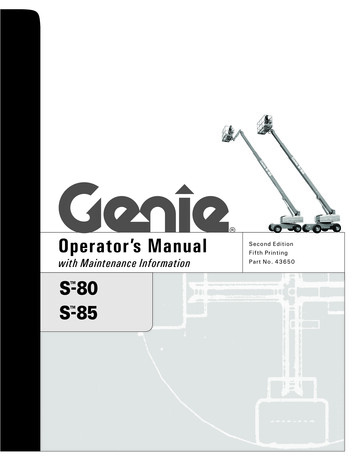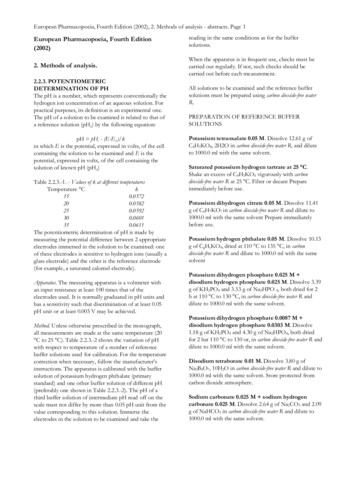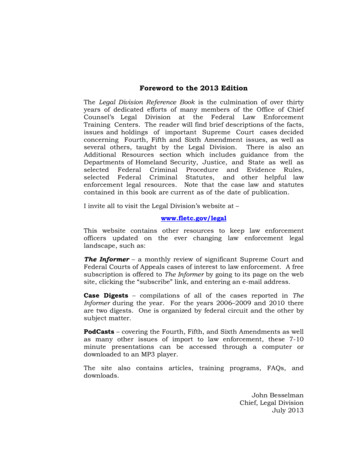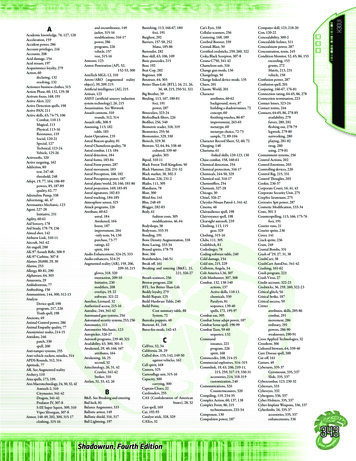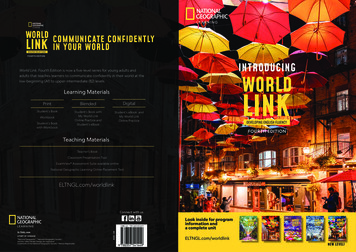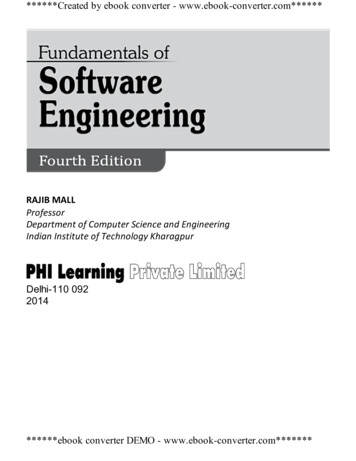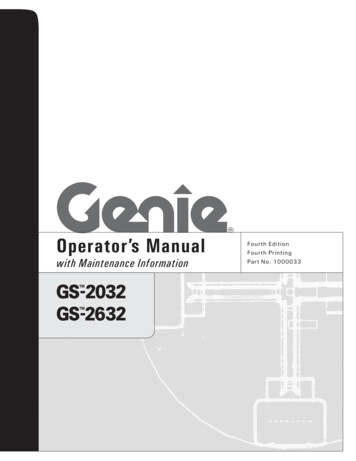
Transcription
Operator’s Manualwith Maintenance InformationFourth EditionFourth PrintingPart No. 1000033
Operator's ManualFourth Edition Fourth PrintingImportantRead, understand and obey these safety rules andoperating instructions before operating this machine.Only trained and authorized personnel shall bepermitted to operate this machine. This manual shouldbe considered a permanent part of your machine andshould remain with the machine at all times. If you haveany questions, call Genie Industries.ContentsPageSafety Rules . 1Legend . 9Controls . 10Pre-operation Inspection . 12Maintenance . 14Function Tests . 16Workplace Inspection . 21Operating Instructions . 22Transport and Lifting Instructions . 27Decals . 30Specifications . 34Copyright 1997 by Genie IndustriesContact us:First Edition: Seventeenth Printing, October 2002Internet: http://www.genielift.come-mail: techpub@genieind.comSecond Edition: First Printing, October 2003Third Edition: Second Printing, July 2004Fourth Edition: Second Printing, February 2006Fourth Edition: Third Printing, May 2017Fourth Edition: Fourth Printing, May 2018"Genie" is a registered trademark ofTerex South Dakota, Inc in the U.S.A. andmany other countries. "GS" is a trademark ofTerex South Dakota, Inc.These machines comply withANSI/SIA 92.6-1999.Printed on recycled paperPrinted in U.S.A.GS-2032 GS-2632Part No. 1000033
Operator's ManualFourth Edition Fourth PrintingSafety RulesDangerFailure to obey the instructions andsafety rules in this manual will resultin death or serious injury.Do Not Operate Unless:You learn and practice the principles of safemachine operation contained in this operator'smanual.1 Avoid hazardous situations.Know and understand the safety rulesbefore going on to the next section.2 Always perform a pre-operation inspection.3 Always perform function tests prior to use.4 Inspect the workplace.5 Only use the machine as it was intended.You read, understand and obey themanufacturer's instructions and safety rules—safety and operator's manuals and machinedecals.You read, understand and obey employer'ssafety rules and worksite regulations.You read, understand and obey all applicablegovernmental regulations.You are properly trained to safely operate themachine.Part No. 1000033GS-2032 GS-26321
Operator's ManualFourth Edition Fourth PrintingSAFETY RULESAllow for platform movement, electrical line swayor sag and beware of strong or gusty winds.Electrocution HazardsThis machine is not electrically insulated and willnot provide protection from contact with orproximity to electrical current.Keep away from the machine if it contactsenergized power lines. Personnel on the ground orin the platform must not touch or operate themachine until energized power lines are shut off.Do not operate the machine during lightning orstorms.Do not use the machine as a ground for welding.Tip-over HazardsMaintain safe distances from electrical power linesand apparatus in accordance with applicablegovernmental regulations and the following chart.VoltagePhase to PhaseMinimum SafeApproach DistanceFeetMetersOccupants, equipment and materials must notexceed the maximum platform capacity or themaximum capacity of the platform extension.Maximum capacity - GS-2032Platform retracted800 lbs363 kgPlatform extended - Platform only550 lbsPlatform extended - Extension only 250 lbs249 kg113 kg0 to 300VAvoid ContactMaximum occupants - ANSI and CSA2300V to 50KV103.0550KV to 200KV154.60Maximum occupants - AustraliaOutdoor useIndoor use only12200KV to 350KV206.10350KV to 500KV257.62500KV to 750KV3510.67750KV to 1000KV4513.722800 lbs / 363 kgGS-2032 GS-2632Extension only Platform only250 lbs / 113 kg 550 lbs / 249 kgPart No. 1000033
Operator's ManualFourth Edition Fourth PrintingSAFETY RULESDo not drive over 0.5 mph / 0.7 km/h with theplatform raised.Maximum capacity - GS-2632Platform retracted500 lbs227 kgPlatform extended - Platform only250 lbsPlatform extended - Extension only 250 lbs113 kg113 kgMaximum occupants - ANSI and CSA2Maximum occupants - AustraliaIndoor use only2500 lbs / 227 kgExtension only Platform only250 lbs / 113 kg 250 lbs / 113 kgDo not raise the platform unless the machine is ona firm, level surface.Use extreme care and slow speeds while drivingthe machine in a stowed position across uneventerrain, debris, unstable or slippery surfaces andnear holes and drop-offs.Do not drive the machine on a slope that exceedsthe slope and side slope rating of themachine.Slope rating applies to machines in thestowed position.Maximum slope rating, stowed position30% (17 )Maximum side slope rating,stowed position30% (17 )Note: Slope rating is subject to ground conditionsand adequate traction.Do not use the platform controls to free a platformthat is caught, snagged or otherwise preventedfrom normal motion by an adjacent structure. Allpersonnel must be removed from the platformbefore attempting to free the platform using theground controls.Do not push off or pulltoward any object outsideof the platform.Do not depend on the tilt alarm as a level indicator.The tilt alarm sounds on the chassis only when themachine is on a slope.If the tilt alarm sounds:Lower the platform. Move the machine to a firm,level surface. If the tilt alarm sounds when theplatform is raised, use extreme caution to lower theplatform.Do not alter or disable the limit switches.Part No. 1000033Maximum allowablemanual forceGS-2032ANSI & CSA - 2 person120 lbs / 534 NAustralia - Indoor use only - 2 personAustralia - Outdoor use - 1 person90 lbs / 400 N45 lbs / 200 NGS-2632ANSI & CSA - 2 personAustralia - Indoor use only - 2 person100 lbs / 445 N90 lbs / 400 NGS-2032 GS-26323
Operator's ManualFourth Edition Fourth PrintingSAFETY RULESDo not alter or disable machine components that inany way affect safety and stability.Do not modify or alter an aerial work platformwithout prior written permission from themanufacturer. Mounting attachments for holdingtools or other materials onto the platform, toeboardsor guard rail system can increase the weight in theplatform and the surface area of the platform or theload.Outdoor Use: Do not raise the platform when windspeeds may exceed 28 mph / 12.5 m/s. If windspeeds exceed 28 mph / 12.5 m/s when theplatform is raised, lower the platform and do notcontinue to operate the machine.Indoor Use: When raising the platform, followratings for allowable side force and number ofoccupants on page 3.Do not operate the machine in strong or gustywinds. Do not increase the surface area of theplatform or the load. Increasing the area exposed tothe wind will decrease machine stability.Do not transport tools and materials unless they areevenly distributed and can be safely handled byperson(s) in the platform.Do not place ladders or scaffolds in the platform oragainst any part of this machine.Do not use the machine on a moving or mobilesurface or vehicle.Be sure all tires are in good condition, castle nutsare properly tightened and cotter pins are properlyinstalled.Do not use batteries that weigh less than theoriginal equipment. Batteries are used ascounterweight and are critical to machine stability.Each battery must weigh 65 pounds / 30 kg.Do not use the machine as a crane.Do not push the machine or other objects with theplatform.Do not contact adjacent structures with theplatform.Do not drive the machine on or near uneven terrain,unstable surfaces or other hazardous conditionswith the platform raised.Do not tie the platform to adjacent structures.Do not replace items critical to machine stabilitywith items of different weight or specification.Do not operate the machine with the chassis traysopen.Do not place loads outside the platform perimeter.Do not place or attach fixed or overhanging loads toany part of this machine.4GS-2032 GS-2632Part No. 1000033
Operator's ManualFourth Edition Fourth PrintingSAFETY RULESFall HazardsCollision HazardsThe guard rail system provides fall protection. Ifoccupants of the platform are required to wearpersonal fall protection equipment (PFPE) due tojob site or employer rules, PFPE equipment and itsuse shall be in accordance with the PFPEmanufacturer’s instructions and applicablegovernmental requirements.Do not sit, stand or climb on the platform guardrails. Maintain a firm footing on the platform floor atall times.Be aware of limited sightdistance and blind spotswhen driving or operating.Be aware of the extended platform position whenmoving the machine.The machine must be on a level surface or securedbefore releasing the brakes.Operators must comply with employer, job site andgovernmental rules regarding use of personalprotective quipment.Check the work area for overhead obstructions orother possible hazards.Do not climb down from the platform when raised.Keep the platform floor clear of debris.Attach the platform entry chain or close the entrygate before operating.Do not operate the machine unless the guard railsare properly installed and the entry is secured foroperation.Be aware of crushing hazards when grasping theplatform guard rail.Observe and use the color-coded direction arrowson the platform controls and platform decal plate fordrive and steer functions.No stunt driving or horseplay while operating amachine.Part No. 1000033GS-2032 GS-26325
Operator's ManualFourth Edition Fourth PrintingSAFETY RULESDo not lower the platform unless the area below isclear of personnel and obstructions.Crushing HazardsKeep hands and limbs out of scissors.Do not work under the platform or in the scissorlinks without the safety arm in place.Use common sense and planning when operatingthe machine with the controller from the ground.Maintain safe distances between the operator, themachine and fixed objects.Component Damage HazardLimit travel speed according to the condition of theground surface, congestion, slope, location ofpersonnel, and any other factors which may causecollision.Do not operate a machine in the path of any craneor moving overhead machinery unless the controlsof the crane have been locked out and/orprecautions have been taken to prevent anypotential collision.Do not use the machine as a ground for welding.Explosion and Fire HazardDo not operate the machine in hazardous locationsor locations where potentially flammable orexplosive gases or particles may be present.Damaged Machine HazardsDo not use a damaged or malfunctioning machine.Conduct a thorough pre-operation inspection of themachine and test all functions before each workshift. Immediately tag and remove from service adamaged or malfunctioning machine.Be sure all maintenance has been performed asspecified in this manual and the appropriateservice manual.Be sure all decals are in place and legible.Be sure the operator’s, safety, and responsibilitiesmanuals are complete, legible and in the storagecontainer located on the platform.6GS-2032 GS-2632Part No. 1000033
Operator's ManualFourth Edition Fourth PrintingSAFETY RULESBodily Injury HazardDecal LegendDo not operate the machine with a hydraulic oil orair leak. An air leak or hydraulic leak can penetrateand/or burn skin.Genie product decals use symbols, color codingand signal words to identify the following:Improper contact with components under anycover will cause serious injury. Only trainedmaintenance personnel should accesscompartments. Access by the operator is onlyadvised when performing a pre-operationinspection. All compartments must remain closedand secured during operation.Safety alert symbol—used to alertpersonnel to potential personalinjury hazards. Obey all safetymessages that follow this symbolto avoid possible injury or death.Red—used to indicate thepresence of an imminentlyhazardous situation which, if notavoided, will result in death orserious injury.Orange—used to indicate thepresence of a potentiallyhazardous situation which, if notavoided, could result in death orserious injury.Yellow with safety alert symbol—used to indicate the presence of apotentially hazardous situationwhich, if not avoided, may causeminor or moderate injury.Yellow without safety alertsymbol—used to indicate thepresence of a potentiallyhazardous situation which, if notavoided, may result in propertydamage.Green—used to indicate operationor maintenance information.Part No. 1000033GS-2032 GS-26327
Operator's ManualFourth Edition Fourth PrintingSAFETY RULESBattery SafetyComponent Damage HazardBurn HazardsDo not use any battery charger greater than 24V tocharge the batteries.Batteries contain acid. Always wear protectiveclothing and eye wear when working with batteries.Electrocution HazardsConnect the battery charger toa grounded, AC 3-wire electricaloutlet only.Inspect daily for damaged cord,cables and wires. Replacedamaged items beforeoperating.Avoid spilling or contacting battery acid. Neutralizebattery acid spills with baking soda and water.Do not expose the batteries or the charger to wateror rain during charging.Explosion HazardsKeep sparks, flamesand lighted tobaccoaway from batteries.Batteries emit anexplosive gas.Avoid electrical shock from contact with batteryterminals. Remove all rings, watches and otherjewelry.Tip-over HazardDo not use batteries that weigh less than theoriginal equipment. Batteries are used ascounterweight and are critical to machine stability.Each battery must weigh 65 pounds / 30 kg.Lifting HazardUse the appropriate number of people a
Operator's Manual Fourth Edition † Fourth Printing 6 GS-2032 † GS-2632 Part No. 1000033 SAFETY RULES Crushing Hazards Keep hands and limbs out of scissors. Do not work under the platform or in the scissor links without the safety arm in place. Use common sense and planning when operating the machine with the controller from the ground.

